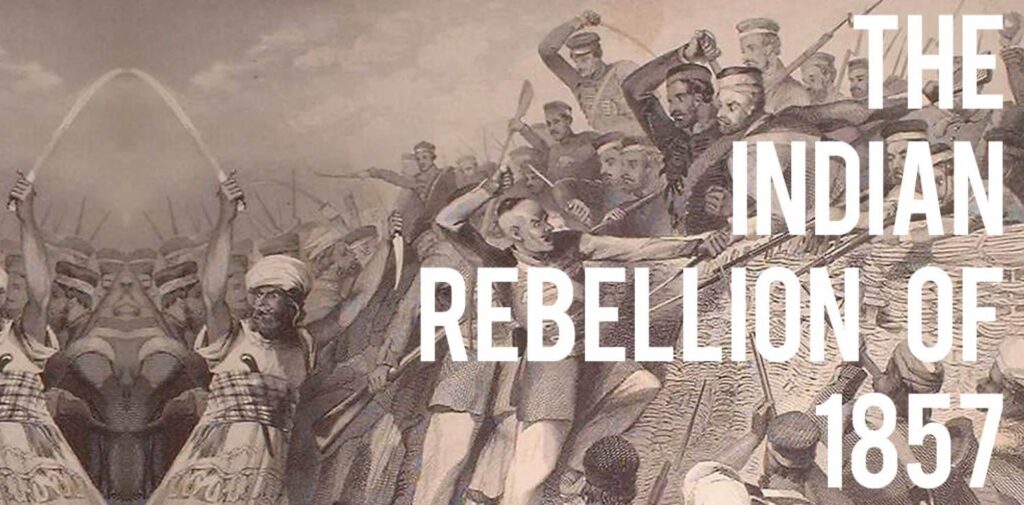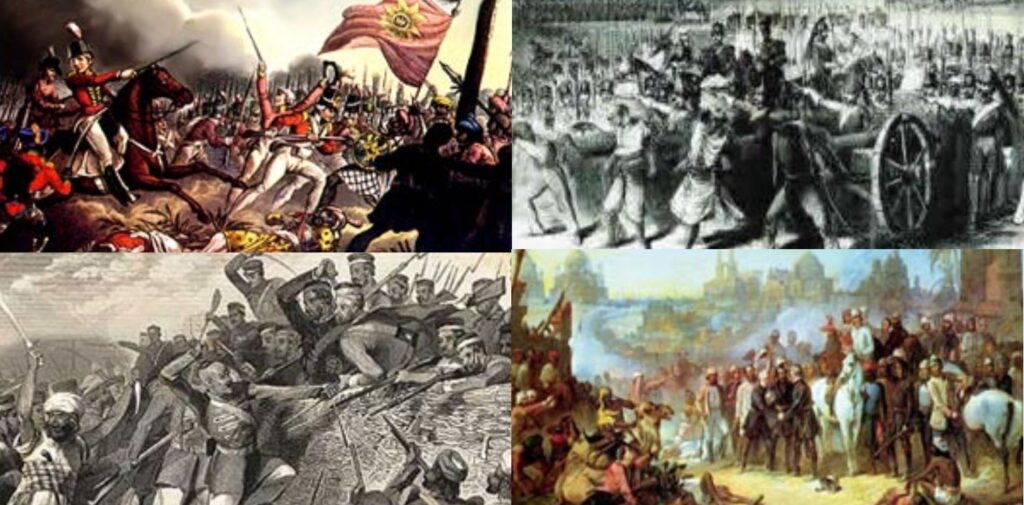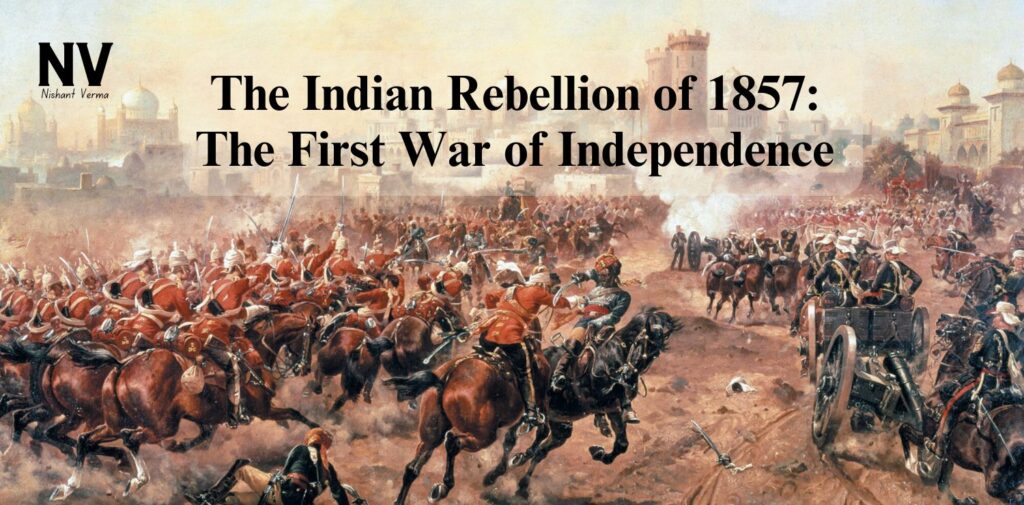The Indian Rebellion of 1857, often called the First War of Independence, was a defining moment in India’s long struggle against British colonial rule. It was not just a simple uprising; it was a turning point that marked the beginning of India’s fight for freedom. Although the rebellion failed to overthrow the British, its impact was far-reaching, leading to significant political, social, and military changes that eventually paved the way for India’s independence in 1947.
In this article, we’ll explore the causes, events, and consequences of the 1857 rebellion, offering insights into how this historical event shaped India’s future.
What Was the 1857 Rebellion?
The 1857 Rebellion, also known as the Sepoy Mutiny or the First War of Indian Independence, was an armed uprising by Indian soldiers, peasants, and rulers against the British East India Company’s rule. It began in May 1857, when Indian soldiers (known as sepoys) in the British East India Company’s army revolted in Meerut, a city in northern India.
While the rebellion started as a military mutiny, it quickly spread to other parts of India and turned into a widespread revolt against British authority. The leaders of the rebellion, like Mangal Pandey, Rani Lakshmibai, Bahadur Shah Zafar, and Tantia Tope, became symbols of India’s resistance against foreign rule.

Causes of the 1857 Rebellion
The causes of the 1857 rebellion were complex and multifaceted. They can be grouped into political, economic, social, and military factors that have been brewing for years.
1. Political Causes:
- Annexation of Indian States: The British East India Company expanded its control over India through aggressive policies of annexation. The Doctrine of Lapse, introduced by Lord Dalhousie, allowed the British to annex any Indian state whose ruler died without a male heir. This caused widespread resentment among Indian rulers, who saw their kingdoms being taken away from them.
- Loss of Traditional Power: Many Indian kings, nawabs, and local rulers had lost their power and influence due to British policies, such as the introduction of British laws and the weakening of the Mughal Empire. This angered them and led them to resist British rule.
2. Economic Causes:
- Heavy Taxes and Economic Exploitation: The British East India Company imposed heavy taxes on Indian farmers, which led to widespread poverty. The British drained India’s wealth by controlling its economy, forcing farmers to grow cash crops for export instead of food crops, causing famines.
- Destruction of Traditional Industries: The British policies of trade and manufacturing destroyed India’s indigenous industries, especially textiles. Indian artisans were out of work, and traditional crafts were undermined by cheap British goods.
3. Social Causes:
- Cultural and Religious Interference: The British introduced laws that were seen as interference in Indian religious and social practices. For example, the introduction of the controversial “Enfield rifle” cartridge, which was rumoured to be greased with cow and pig fat, angered both Hindu and Muslim soldiers. For Hindus, the cow is sacred, while for Muslims, pigs are considered unclean.
- Social Reforms: British social reformers, like Lord Macaulay and William Bentick, pushed for changes in Indian society, such as the abolition of practices like Sati (the burning of widows) and the promotion of Western-style education. While these reforms were meant to modernize India, they were often seen as an attack on traditional Indian values.
4. Military Causes:
- Poor Treatment of Sepoys: Indian soldiers (sepoys) in the British army were often poorly treated, given lower pay, and subjected to discrimination. Many soldiers were unhappy with the way they were treated by their British officers, and the introduction of the new Enfield rifle was the final spark that ignited the revolt.

Key Events of the 1857 Rebellion
The rebellion began in Meerut on May 10, 1857, when Indian soldiers refused to use the new rifle cartridges, leading to a mutiny. This event quickly spread to other parts of India.
- The Mutiny in Meerut: The spark that ignited the rebellion was the refusal of Indian sepoys to use the new rifle cartridges. The soldiers believed the cartridges were greased with animal fat, violating their religious beliefs. When they protested, 85 sepoys were sentenced to prison, which led to a mutiny. The sepoys rebelled, killing British officers and seizing control of the city.
- Spread of the Revolt: The rebellion spread like wildfire across northern and central India. Cities like Delhi, Kanpur, Lucknow, Jhansi, and Bareilly became centres of resistance. The Mughal emperor, Bahadur Shah Zafar, was declared the symbolic leader of the revolt, although he had little power. Rani Lakshmibai of Jhansi, Nana Saheb, and Tantia Tope became prominent leaders in their respective regions.
- Delhi: Delhi, the heart of the Mughal Empire, became the epicentre of the rebellion. Bahadur Shah Zafar was proclaimed as the symbolic leader of the mutiny. However, after months of intense fighting, British forces recaptured Delhi in September 1857.
- Jhansi: Rani Lakshmibai of Jhansi was one of the most prominent leaders of the rebellion. She fought valiantly to defend her kingdom against British forces and became a symbol of bravery and resistance. Unfortunately, her forces were defeated, and she died in battle in 1858.
3. The British Response: The British response was swift and brutal. British forces, aided by loyal Indian soldiers, launched a counterattack, and the rebellion was crushed by mid-1858. The British reasserted control over India and many of the leaders of the rebellion were executed or exiled.
Consequences of the 1857 Rebellion
Although the rebellion was ultimately unsuccessful in overthrowing British rule, it had significant and long-lasting consequences for India and the British Empire.
- End of the Mughal Empire: The British officially ended the Mughal Empire, which had been a symbol of Indian power for centuries. Bahadur Shah Zafar, the last Mughal emperor, was exiled to Rangoon (now Yangon) in Burma, marking the end of a glorious era in Indian history.
- British Direct Rule: Before the rebellion, India was governed by the British East India Company. After the rebellion, the British government took direct control of India, a system known as the British Raj. Queen Victoria was proclaimed Empress of India in 1876, signalling the beginning of a new phase of colonial rule.
- Reforms in British Policies: The British recognized that the rebellion was a result of widespread dissatisfaction among Indians. In the years following the rebellion, the British implemented several reforms, such as:
- Recruiting more Indians into the British army.
- Promoting a policy of religious tolerance.
- Changing land revenue policies to avoid widespread resentment.
4. Rise of Nationalism: The rebellion, though crushed, ignited the spirit of nationalism among Indians. The idea of India as a unified nation began to take shape, and in the following decades, leaders like Bal Gangadhar Tilak, Lala Lajpat Rai, and Subhas Chandra Bose would continue the struggle for independence.

Legacy of the 1857 Rebellion
The 1857 rebellion holds a unique place in Indian history. Though it was suppressed, it marked the beginning of organized resistance to British colonialism. It united people from different walks of life—soldiers, peasants, kings, and common folk—against a common enemy. The bravery of leaders like Rani Lakshmibai, Mangal Pandey, and Tantia Tope continues to inspire generations of Indians.
The rebellion also left the British with a deep realization: controlling India was not going to be easy, and maintaining British rule would require more effort. It set the stage for the eventual Indian independence movement, which culminated in 1947, nearly 90 years later.
Conclusion: The Indian Rebellion of 1857
The Indian Rebellion of 1857 was more than just a military uprising. It was a battle for identity, culture, and freedom. Though the rebellion failed to overthrow the British, it planted the seeds of nationalism that would grow over time and lead to India’s eventual independence. The sacrifices made during this revolt are still remembered and honoured today, reminding us of the courage and determination that ultimately won India its freedom from British rule.
In essence, the 1857 rebellion was not just the beginning of India’s fight for freedom; it was the first spark in a long and courageous journey toward independence.




